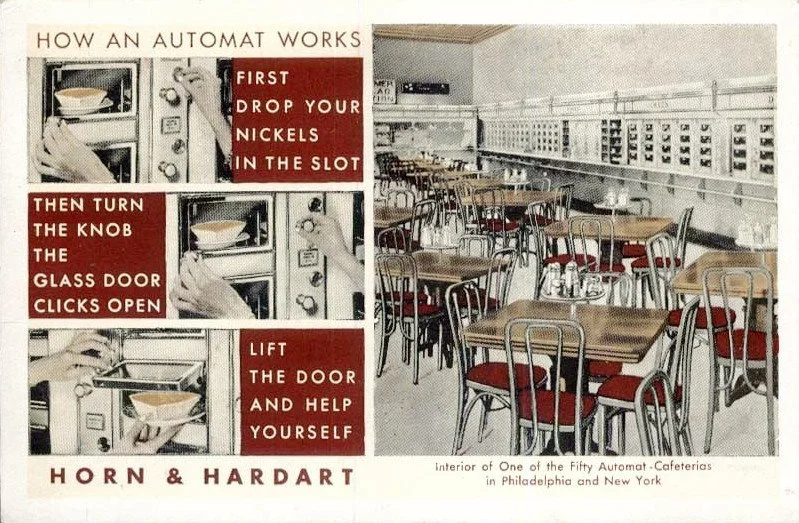Magic for a nickel
The quirky 2021 documentary, The Automat, recalls an interesting slice of Americana.
In the film, Mel Brooks, Ruth Bader Ginsburg, Colin Powell, and others recall growing up on the East Coast and getting food from a Horn & Hardart automat, where the food was displayed behind dozens of small glass windows. You dropped in a nickel, the window unlocked, you removed the plate, and then went to a table to eat.
The first automat was in Germany. They came to the US in the early 1900s and peaked in popularity in the ‘30s, ‘40s, and ‘50s, mostly in New York and Philadelphia. Other cities had automats, too, but for some reason they really took off in those two cities. At one time, Horn & Hardart operated 40 locations in New York City.
The movie argues that automats took on iconic status. Yes, the food was pretty good – maybe not white-tablecloth quality, but better and more varied than the fare in most places at the time. (The coffee, in particular, was heaven sent, apparently). But there was more to them than that.
There was a cool factor. The word “magic” came up repeatedly in the documentary. The mysterious way in which the food was served and the unpredictability and variety of the options was endlessly fascinating.
It was one of the few places where working women in that era could eat an affordable meal and also feel safe.
Everyone ate there, and there was an unwritten rule that as tables filled up, you sat in any chair you could find, even if a stranger was already at that table. So, especially during the Depression, the automat was a great socioeconomic leveler. An unemployed tradesman could rub shoulders with a prosperous banker. An immigrant recently off the boat could be sitting next to some blue-blood whose American roots went back 200 years.
The rise of the suburbs, along with some poor business decisions, led to the decline of Horn & Hardart in the 1960s. Its last location closed in 1991.
In a way, automats are a relic of a bygone time and place, like a Doris Day movie or an old man in a fedora. But there is also something timeless about them, an emotional, cultural, and experiential appeal.
Howard Schultz’s vision for Starbucks was inspired by his childhood experiences in the automat. Automats, the original contactless dining option, probably would have thrived during COVID. In fact, a new automat opened in Jersey City, NJ in 2021 and a specialized dumpling automat is scheduled to open soon in Brooklyn.
One wonders what elements would have to be in place for a full-scale automat revival. Would it be possible under the right circumstances? How would the experience be similar or different to that of the automat of yore?

